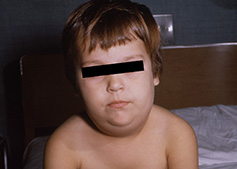PDF 75 KB
Mumps is most common in children and adolescents and is spread by mucous membranes, saliva and droplets from the nose and throat
Mumps is an illness due to infection with the mumps virus.
Mumps is a notifiable condition1
Mumps virus is spread when an infected person talks, coughs or sneezes small droplets containing infectious agents into the air. The droplets in the air may be breathed in by those nearby. Infection may be spread by contact with hands, tissues and other articles soiled by infected nose and throat discharges. Mumps virus is also spread by direct contact with the saliva of an infected person.
 Mumps occurs most commonly in children and adolescents, although symptoms are more severe in adults. About 30% of cases will have no symptoms at all (asymptomatic infections) or only mild symptoms.
Mumps occurs most commonly in children and adolescents, although symptoms are more severe in adults. About 30% of cases will have no symptoms at all (asymptomatic infections) or only mild symptoms.
When present, symptoms include:
Despite popular opinion, sterility following infection is rare. Another rare complication is inflammation of the brain (encephalitis). Meningitis (inflammation of the lining of the brain and spinal cord) from mumps is probably more common and may be accompanied by hearing loss.
The diagnosis is suspected following clinical presentation and can be confirmed by laboratory testing of saliva collected from an oral or buccal (the lining inside the mouth) swab or by a blood test (serology).
(time between becoming infected and developing symptoms)
Generally 14 to 25 days, usually 18 days.
(time during which an infected person can infect others)
Up to 6 days before swelling of the glands begins and up to 5 days after the onset of swelling. Asymptomatic infections can still result in spread of infection. Exposed non-immune people should be considered infectious from the 12th to the 25th day after exposure whether or not they have symptoms.
Treatment of the symptoms includes giving plenty of fluids. Paracetamol may be given for fever and pain. There is no specific antiviral treatment. Aspirin should not be given to children under 12 years of age unless specifically recommended by a doctor.
* A contact is any person who has been close enough to an infected person to be at risk of having acquired the infection from that person.
1 – In South Australia the law requires doctors and laboratories to report some infections or diseases to SA Health. These infections or diseases are commonly referred to as 'notifiable conditions'.
Image - Mumps. Public Health Image Library (PHIL), Department of Health and Human Services, Centers for Disease Control and Prevention (CDC-USA)